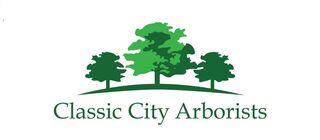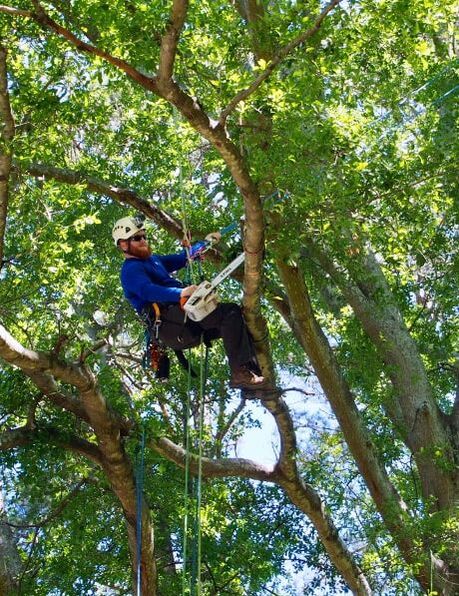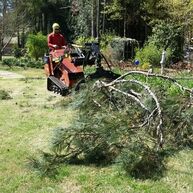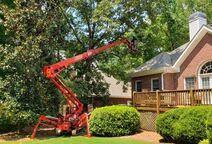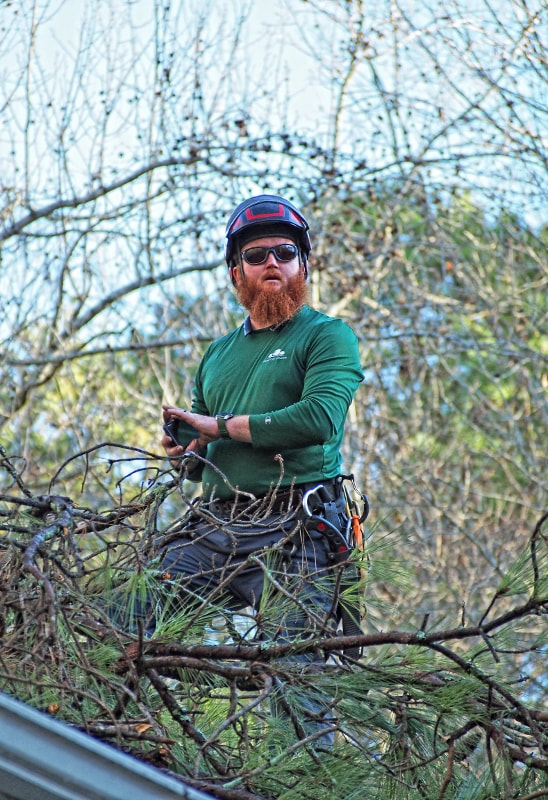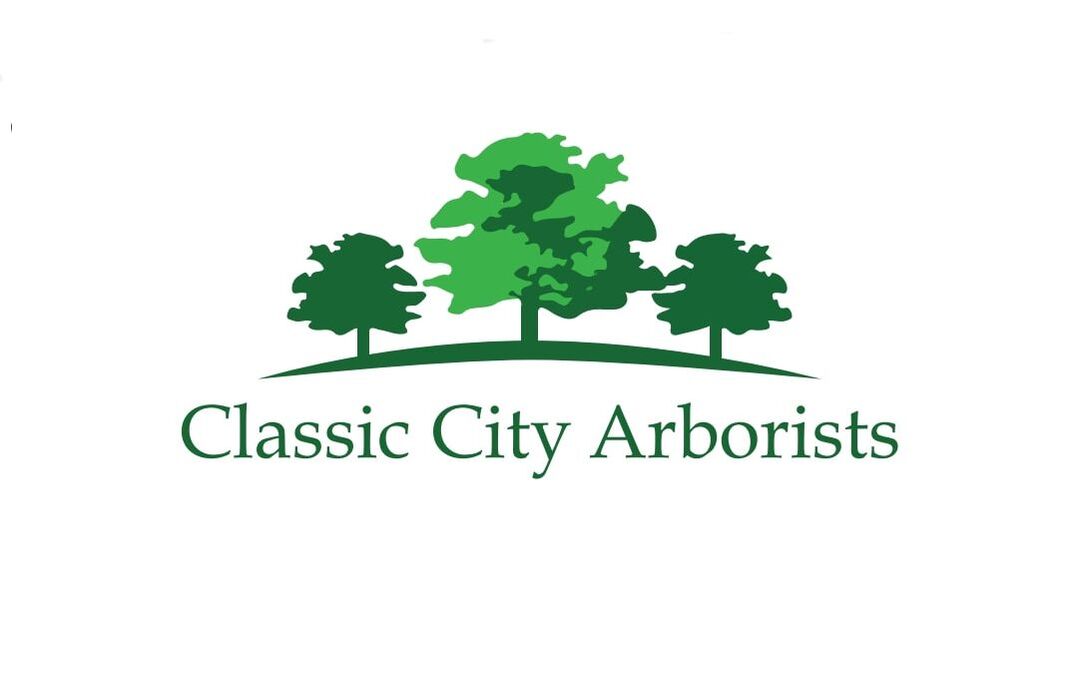|
News and Blog Articles
|
|
While Classic City Arborists was “officially” born in 2014, our story actually begins ten years prior, as a little firewood company operating out of Bishop, Georgia. In 2005, while working on his bachelor’s degree in Agricultural Education from the University of Georgia (go Dawgs!), our owner and Certified Arborist Scott Rushing starts working for a small business called Classic City Firewood. As the name suggests, this little operation provides firewood deliveries to the Watkinsville and Athens areas during the fall. They also provide firewood for some of the restaurants in the area during the off season.
In 2011, the owner of Classic City Firewood, an avid entrepreneur, had started branching out into other businesses, so Scott steps in to keep things going, growing the company’s client base, streamlining processes to be more efficient and effective, and generally devoting his time and effort trying to turn this side job into something more permanent.
The next few years bring exponential growth. Scott purchases additional equipment and gear to allow him to perform more technical, difficult tree removals, and further expand the business’s capabilities. Peyton Mitchell, who has worked off and on with Classic City Firewood since its inception, becomes an invaluable member of the team and Scott’s right-hand man, helping with every job and supporting the vision Scott has for the company. In 2014, the owner of Classic City Firewood starts a family and is ready to move on to other ventures. After countless discussions and lots of prayer, Scott and Rebekah decide to purchase the business Scott has invested so much of his time and effort into. With a few signatures and a grand leap of faith, Scott and Rebekah officially become small business owners, and come up with a new operational name: Classic City Arborists.
All the time and effort this new machine saves allows Scott and his team to complete nearly twice as much work in the same amount of time, helping spur the business forward by leaps and bounds.
As Abigail gets older, Rebekah begins to take over more and more of these responsibilities, until in 2017, she officially becomes the Operations Manager, handling everything from payroll to marketing to scheduling. With the efficiency of the Miniature Skid-Steer, and with Rebekah as the Operations Manager, Scott has more time to devote to giving estimates and working in the field. The workload has doubled, thus doubling the revenue. In 2017, Scott is able to purchase a Chipper and a Dump Truck. Instead of taking load after load of limbs and logs to the dump, most everything can be run through the chipper at the job site. On many occasions, the customer will even choose to keep the wood chips, which saves time hauling the chips away.
A lift is similar to a bucket truck, in that it has an extendable arm with a bucket attached that, as the name suggests, lifts Scott directly to the point of interest on the tree. However, this lift is not part of a truck; it is a separate piece of equipment. Just like the Miniature Skid Steer, the Lift runs on tracks is compact enough to fit through your front door, thus allowing Scott to easily access backyards and tight spots. And that brings us to 2020, where Classic City Arborists operates with a simple four-man team; Scott runs and performs the more technical jobs, but leaves Peyton, the official foreman and second-in-command, in charge while he travels around to perform free estimates for potential customers. Scott handles all the official documents, like estimates, invoices, and pricing. He orders equipment and replacement parts or maintenance supplies as needed and ensures all the tools for the job are in perfect working order. In the mornings, when Scott leaves for work, Abigail has to have "a hug and a kiss, daddy" and Elijah blows him exaggerated kisses. In the evenings, Abigail races to get the first kiss while Elijah toddles behind her, happily calling out "it's da-da". Abigail tells "my daddy" all about her day while Elijah helps unload daddy's lunch box. With the rapid growth of the last few years, Rebekah now dedicates more of her time to the endless array of administrative and operational tasks. She wears many, many hats, including things like customer service (answering the phones, responding to emails, scheduling estimates), human resources (hiring employees, processing payroll), accounting (managing expenses, bills, keeping licensing and insurance up to date, accounts receivable and accounts payable), and marketing (designing and up-keeping the website, planning and executing marketing strategies). What started as a side gig to help pay for college has turned into a life-long career. Scott and Rebekah are proud to own a small, local business, and can’t wait to see what God has planned for their family and for Classic City Arborists. No matter what the future holds, Classic City Arborists will always approach each job with the same integrity we’ve had since day one:
And most of all, we believe in that age-old adage: “Leave it better than you found it.” Whether we’re talking about a job site, a customer’s mood, or our Earth as a whole, at Classic City Arborists, we are on a mission to do what we can to make a positive impact on the lives of everyone we encounter. AuthorEmily Casuccio is sister and sister-in-law to Rebekah and Scott Rushing, and has over half a decade of experience in copywriting, copyediting, proofreading, and developmental storyboarding. She's worked with both published and undiscovered authors on both fiction and nonfiction, and takes pride in supporting local businesses. Her passion lies in the written word and helping authors of all capacities realize their dreams and achieve their fullest potential. To learn more about her, read samples of her work, or contact her, visit her online portfolio.
0 Comments
For April’s Tree of the Month, we want to shine the spotlight on the tree you’ve seen in your backyard, at the park, and along the highway, whether you knew it or not: Pinus tadea, more commonly known as the loblolly pine. These tall, fast-growing evergreens are named after the depressed lowlands of the east coast of the United States that they are native to, and have the second highest population of trees across the country, surpassed only by the red maple. If you’ve ever driven down a back road or old highway and seen tons of tall pine trees planted in clear, evenly-spaced rows, then you’ve seen the loblolly pine. These loblolly “farms” supply a variety of industries, as the loblolly, classified in the lumber industry as a southern yellow pine, can be used for everything from furniture to plywood to pulp for paper and cardboard production. This highly versatile, invaluable resource is by far the most widely cultivated timber species, and arguably the most important. Loblolly 101Perhaps the most notable feature of the loblolly, on first glance, is the name. Loblolly combines the word lob (which refers to the thick, heavy bubbling found when cooking porridge) and lolly (which is an old British word for food boiled in a pot, such as broth or soup). Down here in the South, loblolly means a mudhole or a mire, a use derived from a mudhole’s resemblance to the consistency of porridge or other lollies. Loblolly pines are native to lowlands and swampy areas, and are named after the mudholes and mires they can be found in. As you might guess for a pine tree, the loblolly pine features both pine needles and pine cones. Loblolly needles grow together in fascicles (bunches) of three and reach between 6 and 10 inches long; they range from a darkish yellow-green to a deep, forest green in color. Loblolly cones are oval-shaped and often grow in pairs; they reach lengths averaging between 3 and 6 inches, and can be either male or female. Male cones are yellow, and will shed pollen in the spring. Female cones are also yellow, but will change to green after pollination and eventually fade to a greyish-brown upon falling. The loblolly is, unfortunately for those of us with allergies, one of the top producers of pollen in the southeast—they can produce between 2.5 and 5 pounds of pollen each season. That layer of yellow dust coating everything in sight? Loblolly pollen. The average loblolly matures at around 150 years of age, where it can reach heights from 60 to 100 feet at full maturity, with a branch spread of 25 to 35 feet and a trunk diameter averaging at 3 feet. Loblollies have been recorded living as long as 300 years in highly favorable conditions. The tallest loblolly pine currently measures in at 169 feet high, and can be found in the Congaree National Park in Hopkins, South Carolina. Did You Know?The loblolly pine is dominant on 11.7 million hectares (29 million acres!) of land, and comprises more than half the standing pine volume in the South.
Why the Loblolly?There are many reasons behind the loblolly’s widespread, dense population, one of which is the species’ rapid growth rate. Loblollies grow over 24 inches, or 2 full feet, per year, making them an ideal choice for quick screens; screens, in this instance, refer to a barricade of trees planted specifically to enhance privacy, reduce sound, or otherwise block off a specific area. For example, during construction of a new structure, the surrounding area is usually raised to make way for equipment and machinery, as well as provide space to work. Once the structure is complete, however, the property owner will likely want something growing around their building, or along their property line; that’s where the loblolly steps in. These trees can populate a barren landscape within just a few years, making them one of the first choices for repopulating an area. In addition to growing so quickly, the loblolly pine is extremely tolerant. Though best-suited to full sun exposure (about six hours of direct, unfiltered sunlight per day), it can survive a more shaded existence, and thrives in most soil types, ranging from clay to moist to acidic. The loblolly is also fairly resistant to both drought and flooding, making it less picky than other species and very easy to transplant. This tolerance, in addition to its rapid growth, makes the loblolly ideal for the southeast, and an excellent choice to prevent erosion and rehabilitate damaged soil plots. AuthorEmily Casuccio is sister and sister-in-law to Rebekah and Scott Rushing, and has over half a decade of experience in copywriting, copyediting, proofreading, and developmental storyboarding. She's worked with both published and undiscovered authors on both fiction and nonfiction, and takes pride in supporting local businesses. Her passion lies in the written word and helping authors of all capacities realize their dreams and achieve their fullest potential. To learn more about her, read samples of her work, or contact her, visit her online portfolio. With the days getting warmer and summer on its way, you and your family will probably be spending more of your free time outside. As you enjoy the sunshine, you might realize that some of your trees don’t look so healthy. Maybe their leaves are dying, or maybe they’re riddled with holes. Either way, those trees can and should make you nervous, because if they fail, they can cause bodily harm as well as property damage. But how do you know what’s actually a cause for concern? Though not all indications of decline are easily visible, by keeping your eye out for these five common signs, you will know when it’s time to call your friendly neighborhood arborist! Dead, Dying or Discolored LeavesPerhaps one of the easiest signs to notice is when your tree’s leaves behave abnormally. When a leaf dies, it usually will first change color and then fall from its tree; this is what creates the beautiful reds, vibrant oranges, and stunning yellows we associate with autumn. However, this process is only normal for one season. If the leaves of your tree are changing color and falling off and it’s not Fall, your tree might have some internal issues that’s causing the leaves to die prematurely. Sometimes, leaves will die and fall from only one area of your tree; this might indicate that a particular limb is dead or dying. While this is normal, and the tree will eventually drop this limb, it is better to have an arborist go ahead and remove that limb for safety reasons and the overall health of the tree. Mushrooms and Fungus and Conks, Oh My! Another sign that your tree isn’t as healthy as it should be is the growth of parasitic organisms that feed on organic matter. Though mushrooms can be pretty to look at, and give your tree a fairy tale air, if they’re growing around the base of a tree, it probably means there is damage or rot of the tree’s roots. The fungi happily feeds on this decaying root matter, and while they might not be the cause of a tree’s failure, they are certainly a warning sign. Besides fungi around the base of your tree, you should also keep your eye on fungal growths on the trunk of your tree, such as fungal conks. Fungal conks look like little lamp shades sticking out from a tree’s bark; they are often patterned similar to bark, and may look like a natural growth of the tree. In reality, these conks are actually the fruiting bodies (reproductive sacs) of a type of fungus called mycelium. This fungus can grow at the base of your tree, indicating root decay, or can be festering beneath the bark of your tree, indicating internal trunk decay. There are an endless array of fungi that can grow on your tree, and not all of them are a bad sign; the best course of action if you notice some mushrooms or strange plants appearing on or around your tree is to have a professional arborist perform a simple evaluation to determine the tree’s health. If, after reading this, you’re already thinking of a couple of trees with fungi that might need attention, please give us a call! We offer free estimates, and will investigate the state of your tree and advise whether it needs treatment or removal; an estimate also gives you the cost of the different treatment and removal options, so you can make the most informed decision possible. Insects, Bugs, and Other PestsThough insects and bugs are vital to our ecosystem, we often don’t want to see them—especially in the house! When you notice something like apparent sawdust on your porch, you probably immediately investigate the two most common culprits: carpenter bees and termites. If you notice sawdust around your tree, you should have the same reaction. Those tell-tale little piles of sawdust indicate that insects have burrowed into your tree, and if they’re burrowing, the wood inside is probably dead or dying. Other indications of insects making a home out of your tree include: small pinholes in limbs or tree trunks that indicate an insect’s entry point, dried sap (called resin masses or pitch tubes) on the outside of the tree that leaks after a bug gets in, and even woodpeckers jackhammering away, looking for a tasty meal. Some species of insect will also impact the leaves of your tree; if you see mottled brown spots, or strips of discoloration, or randomly dispersed holes, this might indicate the presence of insects. These insects might also gather on the underside of your leaves without doing too much damage to the leaves themselves, so if you suspect an infestation, be sure to check. Did You Know?One of the most common infestations of pine trees in our area is the pine beetle, also knows as the southern pine beetle, or Dendroctonus frontalis.
These relatively large insects like to live just under the bark of your pine, and leave behind lots of resin masses that might look like polka dots.
They pests move from tree to tree in a directional pattern, resulting in an obvious trail of dead trees. The best course of action is to remove the infected tree as quickly as possible to prevent them from spreading. Canker Sores – Not Just for Your Mouth! The term canker sore probably evokes unpleasant memories of the tiny ulcers that develop in the mouth and on or around the lips, making eating and drinking uncomfortable and even painful. Trees can also develop little sores, referred to as cankers, that leave them vulnerable to further damage, insect infestation, and rot. Cankers often appear on trees plagued by fungi growing between the bark and actually tree trunk, but can be caused by things as simple as damage from your lawn mower or even rough hail. A tree canker sore will appear as nothing more than a small, dead area on the bark, stems, branches, or twigs. Bark cankers appear as a different color than the healthy bark, and might also be indented thanks to the interior decay. The canker becomes something of a magnet for bacteria, fungi, and insects, inviting further infestation and damage to the tree. Because of this, it is extremely important to diagnose a canker as early as possible! Cavities and Hollows If you’ve ever been on a hike, to a park, or wandered through the woods, you’ve probably seen a tree with a cavity, and thought it looked rather cool. These hollows seem like the perfect place for a cute squirrel or mama owl to nest; children’s books often depict these holes as such, suggesting that these occurrences are normal and no cause for concern. Unfortunately, these cavities indicate internal decay and present a high risk of tree failure. At best, these holes reduce the structural integrity of the tree, making it more liable to snap or fall under its own weight in harsh weather. At worst, cavities expose the decaying interior of the tree to external forces, insect infestations, and fungi that cause it to decline even faster and greatly increases the chances that the tree will need to be removed entirely. So What Can You Do? Some cases of insects and fungi growth can be treated. The best thing you can do is keep a close eye on your trees, and have a trained, experienced arborist evaluate anything questionable. The quicker the decay is addressed, the easier it is to reduce the risk of danger to you and your family. At Classic City Arborists, we offer free estimates that include Scott, our certified arborist, coming out to your property to closely inspect the trees you’re concerned about and offer his professional opinion on the best course of action, as well as some estimates for the cost of those actions. Even if you don’t call us, or if you find another company that you’d like to work with, we strongly recommend you find a company that is licensed and insured for the safety of you, your family, your property, and your trees! AuthorEmily Casuccio is sister and sister-in-law to Rebekah and Scott Rushing, and has over half a decade of experience in copywriting, copyediting, proofreading, and developmental storyboarding. She's worked with both published and undiscovered authors on both fiction and nonfiction, and takes pride in supporting local businesses. Her passion lies in the written word and helping authors of all capacities realize their dreams and achieve their fullest potential. To learn more about her, read samples of her work, or contact her, visit her online portfolio. |
Categories
All
Archives
January 2023
|
|
23 Whatever you do, work at it with all your heart, as working for the Lord, not for human masters,
24 since you know that you will receive an inheritance from the Lord as a reward. It is the Lord Christ you are serving.
Colossians 3:23-24
24 since you know that you will receive an inheritance from the Lord as a reward. It is the Lord Christ you are serving.
Colossians 3:23-24
